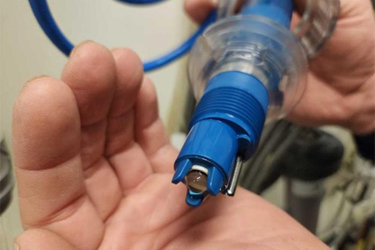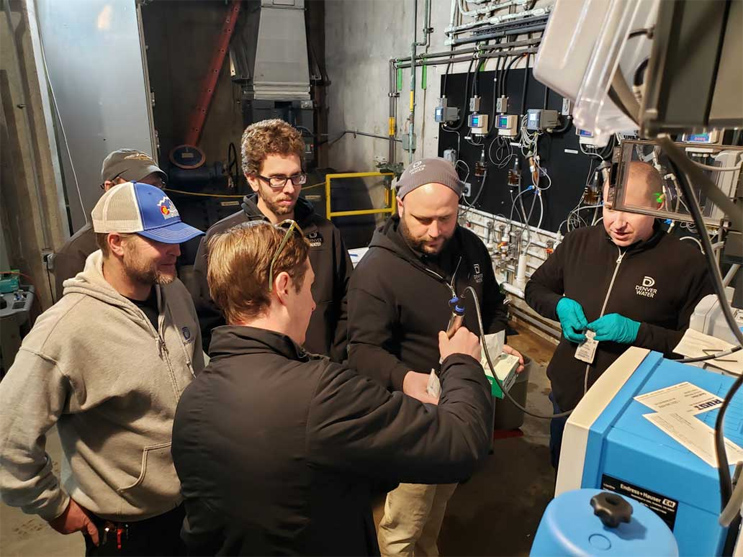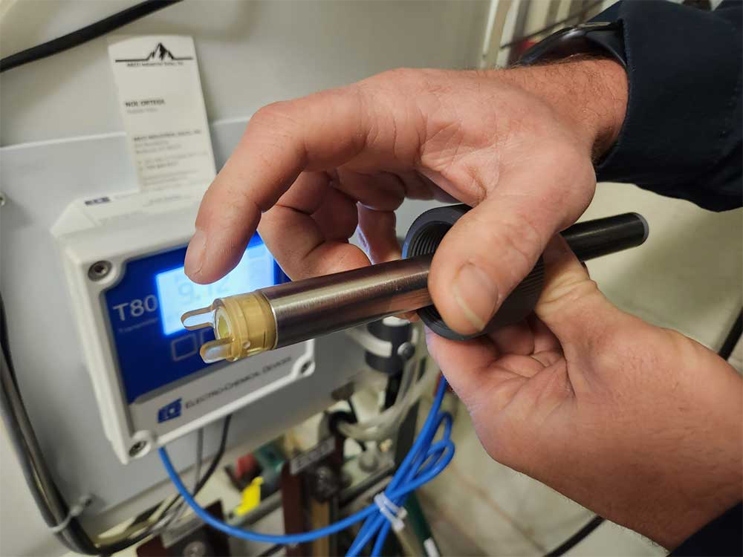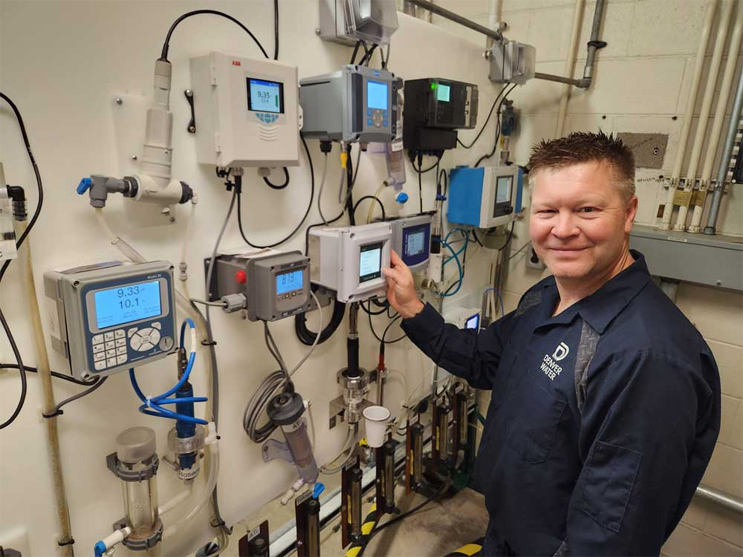Small Things Matter Greatly When It Comes To pH

Denver Water team spent a year studying the best pH probes to protect customers from lead.
A key component of Denver Water’s groundbreaking Lead Reduction Program rests on small, glass-enclosed sensors smaller than your pinky fingernail.
Across Denver Water’s treatment plants and throughout its distribution system, roughly 300 pH probes constantly monitor the water flowing past the probes’ sensors. They report the water’s pH level and temperature to operators trained to watch for and react to the smallest fluctuations.
That’s because, when it comes to pH, the state and federal guidelines for the utility’s Lead Reduction Program require Denver Water to raise and maintain the pH level of the water it delivers to customers at or very near a target of 8.8 on the pH scale. If the levels fall outside a very narrow pH range between 8.5 and 9.1 for too long, the utility could be deemed out of compliance with the program’s requirements.
“We’ve tested and monitored the pH in our water for decades, but the new requirements for the Lead Reduction Program made the pH levels, and keeping the pH levels inside that narrow range, more important than they’d been in the past. And we found that we were asking the existing sensors embedded in our system to go above and beyond what they were designed to do,” said Drake Dennert, an IT industrial controls supervisor at Denver Water.
“We wanted to know if there were pH probes out there that would give us better, more precise results, ensure our customers were protected, that we were meeting the requirements of the Lead Reduction Program — and also save our ratepayers money by reducing maintenance costs,” he said.
So, in March 2022, Dennert’s team launched an innovative, yearlong study of 11 models of pH sensor probes used by the water industry.

The team arrayed the probes, sensors and monitoring equipment on a board mounted at Denver Water’s Marston Treatment Plant in southwest Denver for months, then moved the board to the utility’s Moffat Treatment Plant in Lakewood for additional testing. The probes monitored the pH levels of the water treated at the plants while technicians double-checked the data by collecting and testing water samples every four hours — for months.
PH is measured on a scale of 0 to 14, with 7 considered neutral, meaning there’s a balance between how basic or acidic the water is.
Raising the pH level of water makes it less acidic and therefore less corrosive. That’s important for the Lead Reduction Program because it means that water with a higher pH strengthens an existing protective coating inside the service line or plumbing, which reduces the potential for lead or other metals to get into the water.
In addition to raising the pH of the water, the Lead Reduction Program is protecting Denver Water customers by replacing between 64,000 and 84,000 old, customer-owned lead service lines at no direct cost to the customer, providing pitchers and water filters to customers enrolled in the program, and educating customers in the program about the importance of using filtered water for cooking, drinking and preparing infant formula until six months after their lead service line is replaced.
The pH study team poured more than 1,500 hours of work into evaluating probes from different manufacturers as the probes monitored the water flowing past their sensors. The probe manufacturers volunteered to participate in the study before it started and were kept in the loop about the study’s progress over the course of the year.

Team members charted which sensors were more reliable than Denver Water’s older probes and didn’t have test results that started to “drift” over weeks and months of use. They charted which probes were more stable and which required less maintenance compared to the older probes.
And they charted which probes were more accurate, able to detect and report the small fluctuations in pH levels Denver Water is watching out for. Typically, the older probes could report results within a range that was plus or minus 10% of the actual pH level. Denver Water needed probes that were sensitive to plus or minus 5%, Dennert said.
“We were asking the older, existing probe technology to do things no one in the industry has ever done before. We knew we needed sensors that were reliable, accurate and gave us more precise measurements,” Dennert said.
“A lot of people are looking at this study — including our state health and water quality officials. And we’ve received queries from utilities across the country and in other countries too. A lot of people are very interested in the results of this study.”
The results of the study are expected to be presented at regional and national industry conferences.

But Dennert cautioned that the study focused on the best probes that work for Denver Water’s system, taking into account the minerals and other elements in water Denver Water collects from across thousands of miles of mountain snowdrifts — as well as the utility’s processes to clean that water for delivery to customers.
“Other utilities will need to figure out what will work best for their own systems, their own treatment practices and their own water,” Dennert said.
The study settled on four probes that met Denver Water’s criteria: the Electrochemical Device S80 (ECD), the Mettler Toledo pHure ISM, the Yokogawa FU24 and the Rosemount 3900.
“We didn’t know what to expect, and to have four probes that met our criteria means that we won’t have all our eggs in one basket going forward — in case supply chain issues affect our ability to get probes from a manufacturer in a timely manner,” said Alvin Johnson, an IT industrial controls senior technician who led the study team that worked under Dennert.
The new probes also are expected to save Denver Water — and its ratepayers — money over time because they last longer and require less maintenance. For instance, one of the probes in the study cost an estimated $850 to maintain every year while the four top probes cost about $200 or less to maintain per year.
“I’m excited by the results. The top probes are responsive and easy to calibrate, which will save us time and money because we know they are doing the job we need them to do. We will start rolling the new probes into our system as the old ones wear out and are replaced,” Johnson said.
A video of the team’s presentation of the study results is available here. In addition to Dennert and Johnson, the Denver Water study team included Stephanie Riley, Brandon Flack, James Wylie, Craig McGonagill, Michael Macklin and Bruce Lange.
